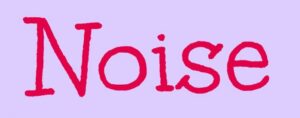Student Contributor: E. Arteaga
 The NOISE Tracker allows students or teacher to quietly alert the class when our noise level is getting too high. When it gets too loud, a student or the teacher can remove a letter from the end of the word “NOISE” (which will be posted at the front of the class). Once only “N” and “O” are left, a class meeting will be called and consequences will be discussed.
The NOISE Tracker allows students or teacher to quietly alert the class when our noise level is getting too high. When it gets too loud, a student or the teacher can remove a letter from the end of the word “NOISE” (which will be posted at the front of the class). Once only “N” and “O” are left, a class meeting will be called and consequences will be discussed.
Noise levels are a very important thing to keep in check in educational environments. Not only can loud environments distract students from learning, but it can overwhelm and even scare some students. To ensure noise levels are kept at a respectful level, this tool can be used to correct levels that get out of hand. Considering most students like to avoid consequences, the idea is that once a letter is removed, the class will notice and settle down to a learning-friendly level. However, if the class is only left with the letters “N” and “O”, a class meeting must be called to discuss why it is important to keep class volume at a respectful level. It is also recommended that if a student takes down a letter, they will be given the opportunity to explain specifically why they did so. Because this is a collaborative strategy, the class and teacher will also agree upon a consequence that addresses to work on the volume level for the future.
This strategy falls into the corrective phase as it only needs to be implemented when the volume is too loud already. In other words, the strategy works to correct class volume that is out of hand and too loud. It can connect to the preventative stage because when the whole word "NOISE" is still complete on the board, students will attempt to keep a respectful volume to ensure a letter isn't taken away. Although it connects in this way, it is still mainly corrective. What makes it corrective is that once "N" and "O" are left, the teacher must step in and call a class meeting. In that class meeting, consequences will be given to the whole class because they failed to fix a problem that was addressed to them.
More Information –
Tool Source: Placement School


